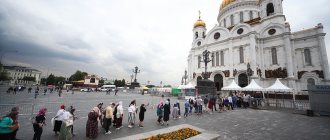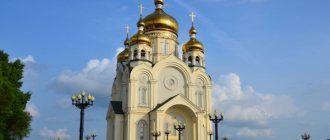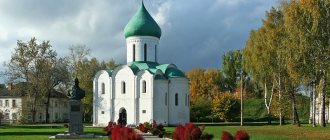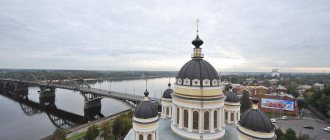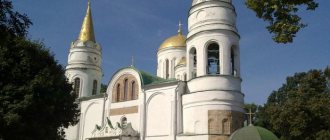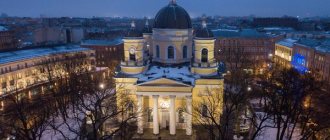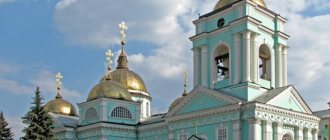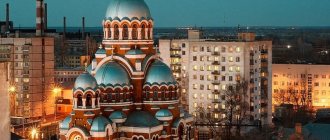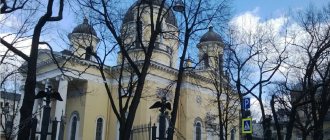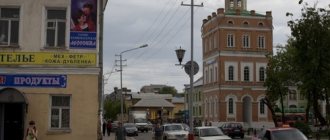In Pskov, in the place where the Mirozha River flows into the Velikaya River, there is the ancient Mirozhsky Monastery, the architectural dominant of which is the Transfiguration Cathedral, which has gained fame as one of the most striking monuments of ancient Russian architecture. Having shared the fate of many Russian shrines during the atheistic hard times, today it has again become the property of believers.
The brainchild of Archbishop Nifont
In the middle of the 12th century, when the political and cultural center of Ancient Rus' shifted from Kyiv to its northwestern regions, the question of their final Christianization arose with particular urgency, since remnants of paganism were still strong there. One of the main initiators of this process was the Novgorod Archbishop Nifont, who occupied the see from 1131 to 1157. Through his labors, many monasteries were founded, the inhabitants of which set a personal example of a truly Christian life.
With his blessing, the Mirozhsky Monastery appeared in Pskov, whose Transfiguration Cathedral became the largest spiritual center of the city for many years. The exact date of the founding of the monastery is unknown, and for this reason, researchers limit themselves to only pointing to the first half of the 12th century. The place for it was chosen a mile from the Pskov “krom” (Kremlin), which allowed the inhabitants to constantly be in the thick of city life, and the monastery itself to become one of the main cultural centers of Pskov during the Middle Ages.
Period of former prosperity
It is known that the Mirozhsky Monastery had one of the largest libraries in the northwestern part of the Old Russian state. In addition, it was famous for its icon painters and copyists of ancient manuscripts. A copy of the famous “Tale of Igor’s Campaign”, which has survived to this day, was created here. And finally, a very important circumstance that contributed to increasing the prestige of the monastery was its wealth, which significantly surpassed most Russian monasteries.
Until the 17th century, on its territory, which occupied the entire floodplain of the Mirozhi River, there were many forges, craft workshops and various types of outbuildings. Only as a result of the secularization of monastic and church lands, carried out in 1764 by decree of Empress Catherine II, the total area of the monastery was reduced to its current size.
During the same period, another striking example of temple architecture of the pre-Mongol period was created - the Cathedral of the Nativity of John the Baptist, erected on the territory of the Ioannovsky Monastery, located on the opposite bank of the Velikaya River in an area called “Zaveliche”. These two largest, at that time, monasteries were assigned a key role in the further spread of Christianity.
Spaso-Preobrazhensky Mirozhsky Monastery Diocesan monasteries of the Russian Orthodox Church
The location of this place is such that, separated from the fortress walls of Pskov by the Velikaya River, the monastery was open on all sides to enemy raids that were frequent in ancient times. Being outside the fortress walls of Pskov, he was the first to take the enemy’s blows. The foundation for the monastery is a limestone rock, barely covered with a thin layer of earth. Thus, the altar part of the Stephen Church is like the bow of a ship, directed into infinity. The construction of the monastery was blessed by Saint Niphon, Bishop of Pskov and Novgorod, a zealous and tireless spreader of Orthodoxy. In the middle of the 12th century, a stone cathedral was founded in honor of the Transfiguration of the Lord, which gave rise to the Mirozhsky monastery. Experiencing deep sorrow because the faith of Christ often coexists in a person with pagan beliefs, Saint Niphon invites the best Byzantine masters to paint the walls of the Transfiguration Cathedral. With an almost complete lack of literacy among the population of the early and late Middle Ages, a pictorial series of scenes from the Old and New Testaments, completely covering the walls and vaults of the Transfiguration Cathedral, becomes a picturesque gospel for many generations. And this blessing of Saint Nifont for the educational mission, given to the Mirozh monastery at its founding, is still effective.
The style of frescoes, according to experts, is hieratic (sacred), in which the religious idea prevails over the free creativity of the artist. All frescoes are copies of the best Greek samples. The first abbot of the monastery was the Monk Abraham, who rested on the day of the celebration of the main monastery icon of the Mother of God “Mirozhskaya”, October 7, according to the new style.
For more than six centuries, Pskov and with it, or rather even primarily the Mirozhsky Monastery, were attacked by Western enemies. None of the disasters that swept over Pskov passed by the Mirozh monastery. With each attack, it was plundered or destroyed by fire, and often even served as a camp for enemies. In 1299, German knights ravaged the city settlements and killed the Mirozh abbot Vasily, many monks and defenders of the monastery. Vasily Mirozhsky, together with Joasaph Snetogorsky, who also acquired the crown of martyrdom at the hands of the Swordsmen at the same time, is a locally revered saint. The Memorial Day of Saints Basil and Abraham of Mirozh is commemorated on March 17th. In 1323, the monastery was again attacked by the Germans. And during the siege of the city by the Polish troops of King Stephen Batory in 1581, it served as a location for enemy artillery. The Mirozhsky Monastery is visually located opposite that section of the fortress wall on the opposite bank of the Velikaya River, where the Poles launched a decisive assault on the city. This place, where the Poles made a hole in the wall, was later called “at the Prolom”. All the enemy forces were thrown here, and only the miraculous intercession of the Mother of God allowed the garrison of the city to survive. The founder of the monastery of St. Niphon was among the saints who accompanied the Queen of Heaven when, on the eve of the decisive assault, she appeared in a dream to the blacksmith Dorotheus.
Despite its open position to enemies, the monastery was never fortified. And after all the disasters it suffered over several centuries, the main cathedral Church of the Transfiguration preserved not only its walls, but even the ancient fresco images, almost contemporary with the foundation of the temple, which even now amaze with their brightness and vivid colors.
So, due to turbulent historical conditions, the monastery could not fully serve as a refuge for monks seeking a solitary and contemplative life. Perhaps the Lord intended the monastery to be a source of evangelical preaching and a spiritual outpost for the protection of Orthodox borders. The Mirozhsky monastery was a true center of spiritual and cultural enlightenment of the Pskov land, where pagan beliefs were still strong in those distant times. From the beginning of its foundation, there was an icon-painting school in the monastery, in which the traditions of the Pskov icon were formed. Among those who received education at the Mirozhsky monastery was St. Cornelius - later abbot of the Pskov-Pechora Monastery, glorified among the venerable martyrs - spiritual writer, educator of the Estonians, tireless organizer of the monastery entrusted to him. In former times, the Mirozh monastery was quite populous; it was considered the second of the four large Pskov monasteries (the first was Snetogorsky, the third Eliazarovsky and the fourth Velikopustinsky). Since the 16th century, the Spaso-Mirozhsky Monastery has been one of the richest among other monasteries in Pskov. He owned lands and peasants, traded in bread, hay, flax, and fish. The urban territory of the monastery occupied the entire floodplain of the Mirozhi River, where there were flour mills, the bank of the Velikaya with baths, forges, and household yards. At the end of the 18th century. The territory of the monastery was reduced to the existing fence.
In the 20s of the twentieth century, the monastery was abolished by the new government and all monastic property, including church relics, were confiscated. The Mirozh Icon of the Mother of God and the cup of Archbishop Nifont were placed in the Pskov Museum-Reserve.
In 1994, His Eminence Eusebius Archbishop of Pskov and Velikolutsk, together with the regional administration, adopted an agreement on the transfer of the Church of the First Martyr Stephen, the fraternal building and the house of the Rector of the Pskov Diocese.
This event marked the beginning of the revival of monastic life in the ancient monastery. A lot of work went into restoring the monastery. It was important not only to begin worship in the church transferred to the monastery, but also to improve the monastic life, as well as to revive the icon-painting workshop that traditionally existed in the monastery. Three years later, on the day of remembrance of the first martyr Archdeacon Stephen, on August 15, 1997, His Eminence Bishop Eusebius consecrated the newly created icon painting school and blessed the work of icon painters from among the monastic brethren.
Currently, services are held on Sundays and twelve holidays. On Sundays at 5 p.m. a prayer service with an akathist is served in front of the Mirozhskaya Icon of the Mother of God. The abbot and the brethren also perform the morning and evening rules in the Church of the First Martyr Stephen. The inhabitants of the monastery, laborers, work in the carpentry workshop, in the boiler room, study and help icon painters in preparing boards and gesso and other work, make souvenirs with the theme of the Mirozhsky Monastery, work in the monastery library, carry out repairs of premises and other obediences.
A new word in temple architecture
According to experts, thanks to the activities of Archbishop Nifont, the middle of the 12th century became a turning point in the development of church architecture in the northwestern part of the Old Russian state. An example of this is the Transfiguration Cathedral of the Mirozh Monastery, which was a temple building of a completely new type for those times. Unlike previously erected religious buildings, the main dominant feature of this cross-domed church was the openness and visibility of the interior.
Despite the fact that the exact date of the foundation of the Transfiguration Cathedral of the Mirozh Monastery is unknown, researchers have reason to believe that this event dates back to 1137-1138. The construction of the main volume of the building, made of plinth - thin baked brick and stone - probably took no more than two years, after which finishing work began.
There is a hypothesis according to which Archbishop Nifont brought with him from Novgorod to Pskov an artel of builders, which could have included Balkan or even Byzantine craftsmen, who then often participated in the construction of various temple buildings. This is evidenced by such features of the Transfiguration Cathedral of the Mirozh Monastery as the arched frieze covering the drum under the dome (it is clearly visible in the attached photographs), and the typical Novgorod masonry of the walls.
Spaso-Preobrazhensky Cathedral of the Mirozh Monastery in Pskov
The Spaso-Preobrazhensky Cathedral of the Mirozh Monastery is a unique in its design and well-preserved monument that has survived to this day, associated with the activities of one of the outstanding figures of the Russian church - Archbishop Nifont. The famous frescoes are a rare example of an almost completely preserved ideological and dogmatic program for the paintings of an ancient Russian temple and reflect the main religious issues of the 12th century.
Spaso-Preobrazhensky Cathedral of the Mirozh Monastery in Pskov. Northern façade.
Story
Historically, in the 11th and early 12th centuries, Kyiv undoubtedly dominated both political and all other spheres of life in pre-Mongol Rus'. However, already in the 30-50s of the 12th century, the center of further development of Russian culture moved to the north-west of Rus', and this is largely due to the activities of Archbishop Nifont, who occupied the Novgorod see from 1131 to 1156. The Greek Niphon came from the Kiev Pechersk Lavra and became the archbishop of Novgorod at a time of political crisis. At this time, a significant part of the Novgorod lands was Christianized only nominally, and in cities such as Ladoga and Pskov paganism continued to take an active position. The only temple in Pskov at that time was the Trinity Cathedral; according to archaeologists, very close to it there was a pagan temple located at the beginning of the 12th century - thus, in Pskov, Christianity literally coexisted with paganism. This is probably why here, in Pskov, and a little later in Ladoga, Bishop Nifont begins to embody his idea of the final Christianization of Russian lands - his initiative is aimed at creating monastic monasteries, where the preaching of Christian ideals could be supported by a concrete example of monastic life. In addition to the Spaso-Preobrazhensky Cathedral of the Mirozh Monastery, construction is underway of the Cathedral of the Nativity of John the Baptist of the Ivanovo Monastery - both churches are being built at approximately the same time.
Historians note that the short period of church construction by Archbishop Nifont is one of the turning points in the history of architecture in northwestern Rus' in the 12th century. And it is the Spaso-Preobrazhensky Cathedral of the Mirozh Monastery that becomes a temple building of a new type, in which, in contrast to the established tradition of Novgorod construction of the early 12th century, visibility and openness of the interior becomes perhaps the main dominant feature of the image of the temple.
Researchers do not have accurate data on the time of construction of the Transfiguration Cathedral. Its foundation may have taken place in 1137-38, and by 1140 the main body of the temple was built. According to other sources, construction began in 1140-1150. Work on painting the cathedral most likely took place around the same time, as evidenced by various technological data.
The cathedral was built in stages, with the original design of the building gradually changing.
Some facts indicate that the construction of the cathedral was carried out by the Novgorod artel, which came to Pskov from Novgorod along with Nifont, but it could also include Byzantine or Balkan craftsmen. For example, one can note the masonry characteristic of Novgorod and the presence of an arched frieze on the drum under the head.
Over the centuries of its existence, the cathedral has repeatedly changed its appearance. In the 16th century, a porch with a belfry, traditional for Pskov architecture, was added to its western façade, and later, in the 17th-18th centuries, the cathedral received a hipped roof that covered the lower part of the dome drum and its windows. This changed the contours of the dome, in addition, its helmet-shaped head was replaced with a bulbous one.
Spaso-Preobrazhensky Cathedral of the Mirozh Monastery in Pskov. Western and southern facades.
Currently, only the eastern facade of the Transfiguration Cathedral, which faces the banks of the Velikaya River, vaguely resembles the appearance of the cathedral in the 12th century. Over the centuries, the soil around the cathedral has grown by about 2 meters, which gives the current proportions of the temple a squat appearance. However, this impression completely disappears inside the cathedral, where the viewer is presented with a magnificent picture of frescoes from the 12th century, preserved throughout almost the entire volume of the walls.
Like most monuments of Russian medieval monumental painting, the frescoes of the Transfiguration Cathedral were whitewashed back in the 17th century. They were discovered and revealed only at the end of the 19th century, when interest in Russian antiquities increased in Russia, which soon became a science about Russian medieval art and its Byzantine roots. The discoverer of the unique frescoes of the cathedral was V.V. Suslov is an archaeologist, restorer and art historian. Through the efforts of Suslov and his students, the frescoes were revealed from under later layers and appeared in their original form. However, the wear and tear of the paint layers, natural for a monument of this age, and the loss of individual sections of the frescoes led to the fact that, by decree of the Synod, an artel of Vladimir icon painters under the leadership of N.M. was invited to “restore” the frescoes. Safronov, who in 1900-1901 washed the ancient paintings, and then rewrote them “in the ancient style,” preserving only the original iconography of the subjects.
In the 1920s, a new uncovering of the frescoes began, but to this day, approximately half of the area of ancient painting is under a layer of renovations in 1901.
Architecture
The original design of the cathedral was a square cross-domed church without a choir, with clearly defined branches of the domed cross.
Spaso-Preobrazhensky Cathedral of the Mirozh Monastery in Pskov. Plan.
It is especially curious that initially the cross-domed structure was clearly revealed by lowering the corner volumes - their ceilings were half as low as the central vaults. The cathedral had three apses, and the side apses were almost half lower than the central one and corresponded in height to the side compartments on the western side.
The first stage of construction of the Transfiguration Cathedral (reconstruction by M.I. Milchik and G.M. Shtender)
This is how the cathedral has been preserved from the inside - with a well-identified cross-domed structure, with wide planes of walls without divisions that smoothly flow into the vaults. Despite the fact that in the 12th century this type of temple was widespread in the Balkans, for ancient Rus' such a structure became something completely new and unlike all other temples - both of that period and earlier ones. Partly because of this, scientists suggest that the team of builders included foreigners.
Transfiguration Cathedral. Northern façade (reconstruction by G. Alferova)
The division of walls with blades and the selection of verticals characteristic of that period are completely absent in this temple; the interior looks very solid and monolithic, and only a few windows, arches in the side volumes and highlighted girth arches add some variety to it. In the interior of the temple there is no emphasis on the support of load-bearing parts. The drum supports (in plan they are read as pillars) are actually continuations of the walls, which in the lower part were only cut through by low arches into corner compartments. The composition of the cathedral is crowned with an unusually spacious dome, the volume of which was increased due to the fact that during construction the walls of the drum were significantly thinned from the inside, which made the structure lighter and increased the internal diameter of the dome by almost 1.5 meters.
Spaso-Preobrazhensky Cathedral of the Mirozh Monastery in Pskov. Dome and vault sails.
For unknown reasons, the architectural composition of the cathedral was changed - the low western compartments were almost immediately built on, and thus the overall level of the facade was raised to the top level of the central vault.
The second stage of construction of the Transfiguration Cathedral (reconstruction of M.I. Milchik and G.M. Shtender)
Although this reconstruction disrupted the clearly defined cross-domed structure of the temple from the outside, it remained practically unnoticeable from the inside. Above the corner rooms there were two small closed volumes of the second floor, equipped for a chapel and a sacristy, and in the space of the western arm of the domed cross, a wooden choir flooring was installed between them, which could be reached via an external wooden staircase through a doorway, hewn in place of the upper window western wall (this opening is now closed, but today it can be easily seen on the facade).
The facades of the Mirozh Cathedral are completely devoid of decorative elements, and their only decoration is a flat, typically “Novgorod” arcature belt in the cornice of the drum.
This architecture gives a rather curious effect: upon entering the temple, a person immediately finds himself under the canopy of the dome. Movement in the space of the temple is reduced to a clearly indicated goal - standing before the altar, as before the throne of the Lord. The dimensions of the surrounding space are perceived as a symbolic distance that exists between the high and the low, the human and the divine.
Frescoes
The architectural image of the Transfiguration Cathedral is closely related to the program of its fresco painting, commissioned by Archbishop Nifont during the completion of the construction of the temple. According to technological data, the team of artists worked from the same scaffolding as the builders, starting with the dome. As we moved down, these scaffoldings were dismantled, and their fastenings in the wall were filled with plaster primer and painted on top. These and other technological traces give a good idea of the methods and sequence of the artists' work. Judging by the seams where the plaster layers join, the craftsmen painted the dome and vaults of the cathedral already in the first working season.
Central apse. General form.
(Illustration from the book by Sarabyanov V.D. Transfiguration Cathedral of the Mirozh Monastery. - M., Northern Pilgrim, 2002.)
Then, due to the fact that changes took place in the temple, the decoration system of the western sleeve of the domed cross was changed (the original program, apparently, did not provide for the appearance of a choir in this area). In places where paintings have been lost in this part of the walls, preliminary markings are clearly visible, according to which the area of the wall under the choir should have been painted with two registers of images. However, with the advent of the choir, there was not enough space for two registers, and images of holy warriors were placed there, which introduced some dissonance into the overall decoration system of the cathedral. However, in general, the interior space of the temple has retained its integrity, which was predetermined by the unity of the architectural and artistic program of Archbishop Nifont.
Presumably the frescoes of the Transfiguration Cathedral were made by an artel of craftsmen called from Kyiv, led by the Greeks. The connection with Kiev is partly indicated by the fact that in the apse of the baptismal chamber of the Kyiv Cathedral of St. Sophia (baptism scene, images of saints) frescoes have been preserved that have a striking resemblance to the frescoes of the Transfiguration Cathedral in Pskov.
The fresco ensemble of the Transfiguration Cathedral reflected the main doctrinal dogma of its time, which worried the minds of Constantinople theologians since the end of the 11th century and was expressed in theological disputes of the mid-12th century. The affirmation of the fundamental tenets of the Christian faith - the reality of the incarnation of God and the hypostatic union of the divine and human nature in Christ - became one of the main leitmotifs of the decoration system of the temple, where the dogma of the divine humanity of Christ is revealed to the viewer in such detail.
Figures of prophets. Drum fresco.
(Illustration from the book by Sarabyanov V.D. Transfiguration Cathedral of the Mirozh Monastery. - M., Northern Pilgrim, 2002.)
The frescoes amaze with their diversity and abundance of subjects. In addition to the detailed Gospel narrative, the scenes of which occupy the upper registers of the central volume, the Acts of the Apostles, the Proto-Gospel of James (the story of the childhood of the Mother of God), the life of John the Baptist, and the apocryphal tale of the Archangel Michael are also presented here. These plots are located in small lateral volumes and represent spatially closed cycles, replete with various narrative details. A number of researchers claim that among the monuments of Byzantine art of this era, the frescoes of the cathedral of the Mirozh Monastery are comparable in detail only to the mosaics of several cathedrals in Sicily, made in the 1140-1180s by Byzantine masters.
The “Deesis” in the conch of the altar with Christ seated on the throne is one of the main dominant features in the cathedral’s painting. On either side of him are depicted the Mother of God and John the Baptist in a pose of prayer. Christ himself is presented in this composition not only as the coming Judge, but also as a Sacrifice offered to atone for human sins. This understanding of this iconographic composition is based on a number of iconographic details, most notably the medallion above the figure of Christ, which depicts the “Etimasia” or “Prepared Throne” - a complex symbolic image of the Holy Trinity, representing the throne on which lies the Gospel and the instruments of the passion of Christ. This motif emphasizes the sacrifice of God the Son.
The theme of the Eucharistic sacrifice is continued by the “Communion of the Apostles” located below, which became a traditional altar subject for the art of the developed 12th century.
Another dominant feature in the cathedral’s painting is the gigantic domed “Ascension”, which in the 12th century also acquired a new meaning and finally affirmed the reality of the union of the divine and human essence in Christ (the very fact of the ascension of the crucified and risen Christ to heaven in the flesh is important). This composition has a number of unique features that will be repeated in other Russian dome compositions of the second half of the 12th century. It is worth paying attention to the number of angels and their placement. If in Byzantine churches we see, as a rule, two, four or, extremely rarely, six flying angels, then in the domed composition of the Mirozh Cathedral there are eight standing angels. Their poses are dynamic - as if they are walking or dancing. The whole scene is permeated with a spirit of joyful glorification and triumph.
Ascension of Christ. The central part of the composition. Fresco of the dome.
(Illustration from the book by Sarabyanov V.D. Transfiguration Cathedral of the Mirozh Monastery. - M., Northern Pilgrim, 2002.)
Compared to the monuments of the previous period, the intonations of teaching and edification in the painting become stronger, the iconography becomes more complex, and the interpretation of three-dimensional forms is completely subordinated to an abstract linear-planar rhythm. The scenes depicted on the walls of the temple are not only objects of consideration and reflection, but also a kind of commentary on the sacred rites that take place during the service.
There is no excessive drama in the plot action in the paintings. The characters' poses are emphatically restrained, their emotions are stingy, their faces are serious and intently attentive, their gazes are either searchingly stern or submissive and meek. The characters in the scenes act both as eyewitnesses of the miracle, and at the same time as witnesses to the “incarnation” of Christ, his coming to people and being with them.
The theme of “coexistence” with people is especially important: in every scene Christ is presented as silently dispassionate and as if removed from active action. What he performs is, first of all, a sacrament, and it is evidenced not only by the looks and repeatedly repeated pointing gestures of the participants in the gospel events, but also by the light emanating from the depths of the paint layer, not bright, but penetrating all the images, shimmering in shades of azure blue, golden yellow and pure white color. This radiance, like the air filling the space of the cathedral, unites all the images into a single scene, which represents the mystery of the appearance of the divine glory of Christ. This affirms the idea that gospel history exists outside of time, being the mystical reality of church life.
Currently, the ensemble of the Spaso-Preobrazhensky Mirozhsky Monastery is a monument of federal significance and is applying for inclusion in the UNESCO World Cultural Heritage List.
Changes made over the centuries
Research shows that the current appearance of the cathedral was formed as a result of stage-by-stage structural changes to the original design. Thus, in the 16th century, a belfry and porch, typical of the architecture of ancient Pskov, appeared on the western facade, and a century later the roof was rebuilt, receiving a hipped roof that obscured the base of the drum and the lower part of the windows cut into it.
The helmet-shaped dome, apparently built by Novgorod masters, which was very characteristic of most of the temple buildings they erected, gave way to the traditional Pskov onion at the end of the 17th century, which allowed the Transfiguration Cathedral of the Mirozh Monastery to organically fit into the overall architectural appearance of the city.
Time imprints
Nowadays, it is almost impossible, looking at the cathedral, to imagine what it looked like during the time of its founder, Archbishop Nifont. This is explained not only by repeated reconstructions carried out over almost nine centuries, but also by the fact that over this long period the ground level around its walls rose by almost two meters (a fact established as a result of work to strengthen the foundation), causing the original proportions of the building to be violated , and it took on a more squat appearance.
Only the western façade, facing the Velikaya River, has to some extent retained its previous outline due to the natural topography of the soil. At the same time, as soon as you enter inside the building, the impression changes radically, and the Transfiguration Cathedral of the Mirozh Monastery appears in all its pristine glory, and all thanks to the superbly preserved wall paintings of the 12th century, covering the entire surface of the walls, which have not lost their original proportions.
First unveiling of the frescoes
The cathedral frescoes, which are of significant interest to art historians, have had a long and difficult life. It is known that in the 16th century, due to the peculiarities of the architectural fashion of that time, they were hidden under a layer of whitewash and forgotten for almost three centuries. Only at the end of the 19th century were they discovered by chance and, since the general interest in ancient art sharply emerged during that period, were they cleared of superficial deposits.
As a result, not only pilgrims, but also simply lovers of antiquity, of whom there were quite a lot among representatives of all walks of life, flocked to the Spaso-Preobrazhensky Cathedral of the Mirozh Monastery. It was the excitement that arose around the ancient frescoes that played an extremely bad role in their fate.
Re-restoration of the cathedral wall paintings
The fact is that, wanting to support the massive influx of visitors, the Holy Synod issued an order not only to restore the frescoes, but to give the colors, which had faded over the years, their original brightness. For this purpose, an artel of icon painters led by N. M. Safonov was invited from Vladimir.
Since it seemed impossible to them to achieve the desired result while keeping the original painting layer intact, the masters covered it with their own paintings, designed “in the old style.” Thus, the priceless monument of ancient Russian art was once again hidden from the eyes of visitors. Only in the 1920s did the re-cleaning of the frescoes of the Spaso-Preobrazhensky Cathedral of the Mirozhsky Monastery begin. Their final restoration has not been completed to this day.
Otto Parley
In the late 1880s, historian, architect and restorer V.V. Suslov, on instructions from the diocesan administration and the Archaeological Commission, conducted archaeological research in the Transfiguration Cathedral. From 1889 to 1893, work was carried out to clear the fresco paintings; in the process, it turned out that the cathedral was completely painted, but the preservation of the frescoes in different parts of the building is not the same and there are many losses. The painting of the dome, light drum, sails and the lower part of the building, where the frescoes were completely destroyed by damp, were poorly preserved.
In 1893, the Academy of Arts and the IAK again sent V.V. Suslov and other specialists to examine ancient paintings. From July 3 to October 26, 1897, the artist F. M. Fomin made copies of the frescoes under the direction of V. V. Suslov. In the same year, Emperor Nicholas II allowed the formation of a “Construction Committee to guide and supervise the correction and repair work in the Transfiguration Cathedral.”
Renovations began in May 1898 and continued until 1902. The masters of the icon painting artel N. M. Safonov resumed the painting discovered by Suslov: the frescoes damaged by moisture were painted anew, and all the surviving ones were “refreshed” with glue paints. During the Safonovsky renovation, in 1901, the frescoes were photographed by photographer O. I. Parly ,
an album was published in the same year. In the photographs of the album, some of the frescoes are recorded in an open, not yet renewed form.
The ROSPHOTO collection contains a tray folder with 86 silver bromide prints made by the photographer in 1901, as evidenced by the embossed inscription on the front cover in the lower right corner: “Issued to a full member of the Pskov Arch(eological) Society O. I. Parley 1901.”
All photographs are pasted onto gray cardboard, and only 4 are pasted onto branded mats; on them, in the lower right corner of the mat, you can see the embossing “Photograph of O. Parly, former Dmitrieva. Pskov,” and in the corners of the photographs: “O. Parley. Pskov. 1901".
The size of the photographs is 17 x 23 cm, the size of the mat is 28.5 x 36 cm. On the reverse side of many mats there is the seal of the Academy of Arts - “The artistic value is approved by the Imperial Academy of Arts.” The photographs in this collection are the only complete source that has preserved images of the frescoes of the Spaso-Mirozhsky Monastery of the 12th century, photographed during the process of their restoration .
The collection includes: Plan of Pskov 1581; plan of the Mirozhsky monastery; general view of the monastery - 4 photographs; the rest of the photographs, except two, which show the interior before restoration, are dedicated to the frescoes.
Photographs by O. I. Parly are also in the collections of the State Academy of the History of Material Culture, the Russian National Library, the Academy of Arts, the Pskov Museum, the State Historical Museum, and the Shchusev Museum of Architecture.
Bibliography:
Parley O.I. Frescoes of the Church of the Transfiguration of the Lord in the Pskov Spaso-Mirozhsky Monastery. Album of photographic photographs - Pskov, 1903; The description of the frescoes was compiled by F. A. Ushakov.
Sarabyanov V.D. Transfiguration Cathedral of the Mirozh Monastery - M.: Northern Pilgrim, 2010. - pp. 5–23.
Vzdornov G.I. History of the discovery and study of Russian medieval painting (19th century) - M/: Art, 1986. - P. 159. A newly discovered monument of antiquity - TsV 1893 No. 28 p. 437–439 and No. 29 p. 452–453.
Ushakov F.A. Spaso-Mirozhsky Monastery in Pskov - Pskov, 1902. - P. 8–13.
Tolstoy I., Kondakov N. Russian antiquities in monuments of art. Monuments of Vladimir, Novgorod and Pskov - St. Petersburg, 1899. - P. 178. Frescoes of the Mirozhsky Monastery.
Uspensky A.I. Frescoes of the Church of the Transfiguration of the Holy Mirozhsky Monastery - Notes of MAI, 7. - M., 1910. - P. 1–12.
Pavlinov A.M. Spaso-Mirozhsky Monastery in Pskov // Antiquities. Proceedings of the Moscow Archaeological Society. M., 1889. - XIII century. 1. - pp. 154–162.
Soboleva M.N. Murals of the Transfiguration Cathedral of the Mirozhsky Monastery in Pskov // Old Russian Art. Artistic culture of Pskov - M., 1968. - P. 8.
Imperial Archaeological Commission (1859–1917). To the 150th anniversary of the founding of Russian archeology and protection of cultural heritage / scientific. ed.-comp. A. E. Musin, under the general direction. ed. E. N. Nosova. - St. Petersburg: Dmitry Bulanin, 2009. - pp. 973–984.
The uniqueness of the frescoes of the Mirozh monastery
According to experts, the uniqueness of the frescoes, in addition to their high artistic level, lies in a carefully thought-out and elaborate iconographic concept, as well as in the fact that in terms of the style of their execution they are completely devoid of chronological analogues on the territory of Russia and are partly similar only to some examples of Byzantine wall painting .
The main motive in the picturesque design of the cathedral’s interior is the idea of a single and inseparable merging in Jesus Christ of the divine and human nature, as well as His atoning sacrifice. This is precisely what the plots of the main elements of the temple decoration are devoted to, among which the giant domed image of the Ascension of the Savior, as well as the Deesis written on the spherical altar ceiling, make the greatest impression on the audience.
The frescoes of the Transfiguration Cathedral of the Mirozh Monastery, rescued after a long stay under thick plaster, and then freed from the later layers of painting applied to them, have today regained their former appearance. However, the complex and painstaking work of restoring them takes so much time that it continues to this day.
Frescoes of the Mirozhsky Monastery through the eyes of Sretensky youth
When the youth of the Sretensky Monastery went on a pilgrimage to the Pskov region in May, no one could have imagined what wonders of the Russian land they would encounter. The God-created caves of the Pskov-Pechersky Monastery are amazing in themselves. The Slovenian springs of Old Izborsk are beautiful. Diven in its grandeur is the Trinity Cathedral of the Pskov Kremlin. But the real discovery of this spring for the children was the ancient Mirozhsky monastery, which is located on the bend of the Mirozh and Velikaya rivers. You understand the uniqueness of this small monastery when you find yourself inside the central Transfiguration Cathedral, decorated with frescoes from the 12th century.
They should have died immediately after writing. There is no other work of this scale that has survived in Russia. The appearance of iconographic images was prevented by the boyars of Novgorod: they did not understand why Bishop Niphon hired expensive craftsmen from Greece to the distant Pskov monastery (financially dependent on the Novgorod principality).
Why spend a lot of money on illustrating the Gospel on the walls of a cathedral? However, the education of an illiterate population required such preaching. Every parishioner had to understand the main events in the life of Jesus Christ. For this purpose, it was necessary to paint all the walls of the cathedral, making it a large visual book. Here are some facts about the frescoes of the Mirozhsky Monastery.
• The Transfiguration Cathedral was built in a lowland. Every spring, during high water, the cathedral was flooded a meter or two above floor level.
Watermark. Transfiguration Cathedral. May 2021 |
• For an unknown reason, it was in the regularly flooded temple that it was decided to paint the largest frescoes in all of Rus'.
Frescoes. Transfiguration Cathedral. May 2021 |
• They paint frescoes on wet plaster, which, after application, dries completely in 14 hours. In 14 hours it was necessary to paint the entire fresco: both the background and the main figures, inscribing the image into the architecture of the temple.
Outline of a figure in a fresco. Transfiguration Cathedral. May 2021 |
• Unique paints are used for unique frescoes. Precious and semi-precious stones are crushed, filled with lime water and left on the plaster. After drying, the paint itself becomes a protective crust that is highly durable. In terms of brightness, these images are not inferior to any other works of art of later centuries.
Transfiguration. Transfiguration Cathedral. May 2021 |
• The dullest areas of the frescoes are attempts to restore the original images in the 20th century. One can appreciate how much more successful the technologies of the Middle Ages were.
Cathedral wall. Transfiguration Cathedral. May 2021 |
• In the 17th century, the frescoes were whitewashed, which contributed to their preservation. Through the efforts of archaeologist and art historian Vladimir Suslov and his students, they were discovered from under the plaster at the end of the 19th century.
Image of the apostles in a boat. Transfiguration Cathedral. May 2021 |
Archangel Gabriel. Transfiguration Cathedral. May 2021 |
• In 1942, a bomb flew into the window of the temple, slightly touched the wall, but miraculously did not explode.
The wall after the bombing. Transfiguration Cathedral. May 2021 |
• Usually, the plot of the Last Judgment is placed above the doors of the temple so that parishioners do not lose the memory of death and the last days. In the Spaso-Preobrazhensky Cathedral above the exit there is a depiction of the plot of Pentecost - an invitation to join the miracle of the Risen Christ.
In the Spaso-Preobrazhensky Cathedral above the exit there is a plot of Pentecost - an invitation to join the miracle of the Risen Christ
The Descent of the Holy Spirit on the Apostles |
Currently, restoration work is underway on the territory of the monastery. In 2021, the Transfiguration Cathedral was included in the UNESCO World Heritage List as the only one in Russia where pre-Mongol painting is well preserved.
You can help the monastery using the following bank details:
r/s: 40703810951010100051 in the Pskov OSB No. 8630, Pskov,
c/s: 30101810300000000602, INN: 6027027032, BIC: 045805602
